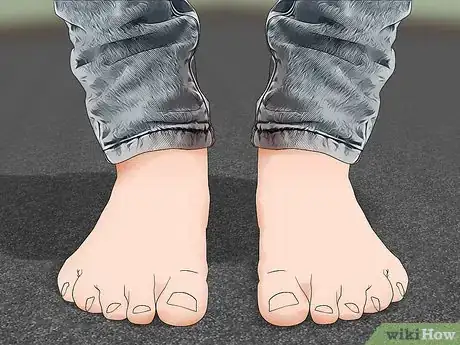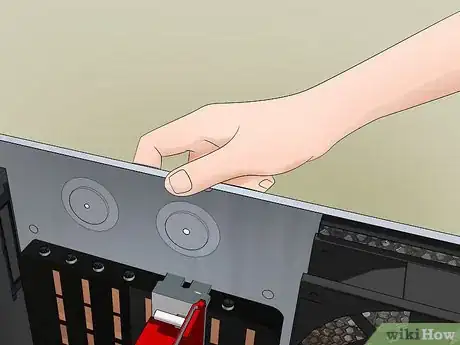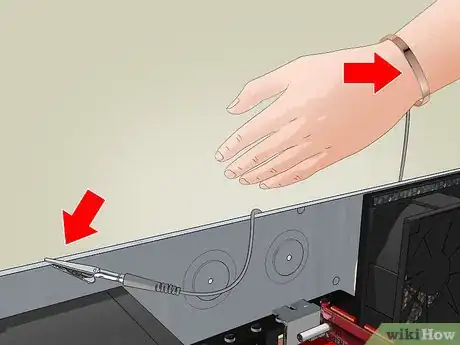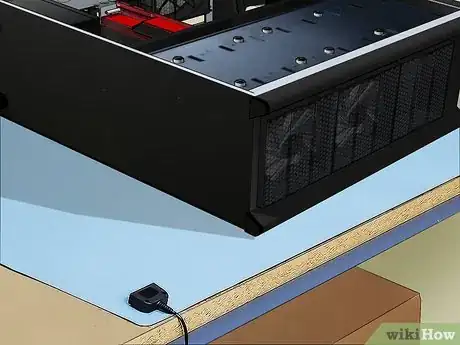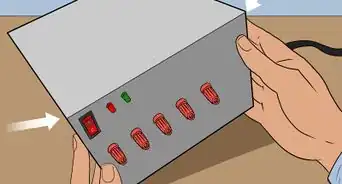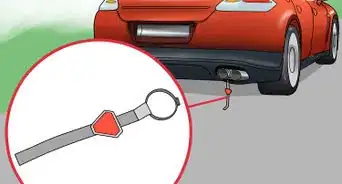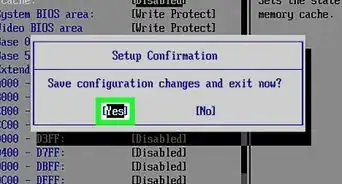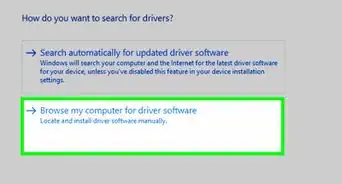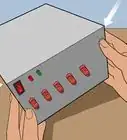This article was co-authored by Luigi Oppido and by wikiHow staff writer, Jack Lloyd. Luigi Oppido is the Owner and Operator of Pleasure Point Computers in Santa Cruz, California. Luigi has over 25 years of experience in general computer repair, data recovery, virus removal, and upgrades. He is also the host of the Computer Man Show! broadcasted on KSQD covering central California for over two years.
wikiHow marks an article as reader-approved once it receives enough positive feedback. This article received 15 testimonials and 84% of readers who voted found it helpful, earning it our reader-approved status.
This article has been viewed 1,436,132 times.
Want to make repairs or add parts to your PC without worrying that you'll short out a vital component? Grounding yourself is an easy way to avoid damaging your computer's delicate internal parts with electrostatic discharge (static electricity). This wikiHow article will walk you through the safest way to open your computer and show you how to de-static yourself with several grounding methods.
Steps
Preparing Your Work Surface
-
1Work on a hard surface. Assemble or take apart computers on a clean, hard surface to minimize static buildup. A table, countertop, or a plank of wood will work fine.[1]
- Your computer should never be placed on a surface such as carpet, a blanket, or a towel when performing any action that requires you to ground yourself.
-
2Stand on a hard floor in bare feet. Carpets and socks can give you a charge. Stand in bare feet on wood, tile, or other hard floors instead.[2]
- If you don't have the option of not standing on carpet, you'll need to be especially proactive about grounding yourself once every couple of minutes.
- You can wear rubber slippers to completely block your connection to the floor, but this is excessive for home projects.[3]
- Any shoe with rubber soles should also be enough to block your connection to the floor.
Advertisement -
3Take off all static-friendly clothing. Wool and some synthetic fabrics are especially good at gathering static, so remove these if possible and replace them with cotton clothing.
- If possible, wash and dry your clothes using a dryer sheet to minimize static build-up before working on your computer.
-
4Humidify in dry weather. Static electricity is a much bigger risk in dry environments. Run a humidifier if you happen to have one, but don't bother buying one if not. The other precautions should be more than enough on their own.[4]
- You can also humidify by hanging wet cloth in front of a radiator or fan.
-
5Keep all components in antistatic bags. All new computer components should stay in the antistatic bags they were sold in until ready for installation.
Grounding Yourself
-
1Understand how grounding works. To prevent built-up static from transferring from you to a sensitive computer component, you'll need to discharge the static into something more durable. In most cases, this is a metal item that is either touching the floor or touching a series of items leading to the floor.
-
2Use your computer's case to ground yourself. Most builders use this technique: before touching or installing something that can be harmed by ESD (e.g., the motherboard), place your hand on an unpainted metal piece of the computer's case.
- You can even lay your non-dominant arm on the metal part of the case while installing the component if you want to be positive that ESD won't harm it.
-
3Touch grounded metal objects every couple of minutes. This must be unpainted metal with a clear ground path, such as a metal radiator or the bay shielding on your computer's case. This is the quick and easy option, and many people build computers without taking any other precautions.
- There's a small but definite risk that this will not be enough. Rely on this only if your project is quick and the components are not valuable.
-
4Ground yourself with an anti-static wristband. These cheap items are sold at electronics stores and in online markets. Wear the wristband tight against your skin, and clip the dangling end onto a grounded, unpainted metal object such as a screw.[5]
-
5Connect yourself to a grounded metal object via a wire. A common technique for keeping oneself grounded is tying a conductive wire, such as copper, around one's toe or wrist and then tying the other end around a grounded, unpainted metal object. This is ideal if you have the materials on-hand and don't have a way to work on a hard surface.
-
6Work on an ESD mat. Buy an ESD mat rated for "conductive" or "dissipative", then place the computer parts on the ESD mat and touch the mat as you work. Some models will have a place to clip your wristband onto as well.
- Go with a vinyl ESD mat for computer repair; rubber is more expensive and not necessary for this purpose.
- Unless you value your peace of mind highly, this is above and beyond for most home projects.
Expert Q&A
-
QuestionCan you move around when you're working on a computer?
 Luigi OppidoLuigi Oppido is the Owner and Operator of Pleasure Point Computers in Santa Cruz, California. Luigi has over 25 years of experience in general computer repair, data recovery, virus removal, and upgrades. He is also the host of the Computer Man Show! broadcasted on KSQD covering central California for over two years.
Luigi OppidoLuigi Oppido is the Owner and Operator of Pleasure Point Computers in Santa Cruz, California. Luigi has over 25 years of experience in general computer repair, data recovery, virus removal, and upgrades. He is also the host of the Computer Man Show! broadcasted on KSQD covering central California for over two years.
Computer & Tech Specialist No, I really wouldn't do much walking or shuffling. Whenever I'm working on a computer, I make a conscious effort to keep my feet planted so that I'm not walking, shuffling, or dragging my feet.
No, I really wouldn't do much walking or shuffling. Whenever I'm working on a computer, I make a conscious effort to keep my feet planted so that I'm not walking, shuffling, or dragging my feet. -
QuestionWhat kind of surface is best for working on a computer?
 Luigi OppidoLuigi Oppido is the Owner and Operator of Pleasure Point Computers in Santa Cruz, California. Luigi has over 25 years of experience in general computer repair, data recovery, virus removal, and upgrades. He is also the host of the Computer Man Show! broadcasted on KSQD covering central California for over two years.
Luigi OppidoLuigi Oppido is the Owner and Operator of Pleasure Point Computers in Santa Cruz, California. Luigi has over 25 years of experience in general computer repair, data recovery, virus removal, and upgrades. He is also the host of the Computer Man Show! broadcasted on KSQD covering central California for over two years.
Computer & Tech Specialist Hardwood or concrete is going to be good. Carpeting is going to be the worst option. If you're on a hard surface, make sure it's unpainted. Paint can often make it difficult to stay grounded.
Hardwood or concrete is going to be good. Carpeting is going to be the worst option. If you're on a hard surface, make sure it's unpainted. Paint can often make it difficult to stay grounded. -
QuestionHow can I permanently ground myself to avoid electric shock?
 Luigi OppidoLuigi Oppido is the Owner and Operator of Pleasure Point Computers in Santa Cruz, California. Luigi has over 25 years of experience in general computer repair, data recovery, virus removal, and upgrades. He is also the host of the Computer Man Show! broadcasted on KSQD covering central California for over two years.
Luigi OppidoLuigi Oppido is the Owner and Operator of Pleasure Point Computers in Santa Cruz, California. Luigi has over 25 years of experience in general computer repair, data recovery, virus removal, and upgrades. He is also the host of the Computer Man Show! broadcasted on KSQD covering central California for over two years.
Computer & Tech Specialist There are these grounding strips you can buy that go around your wrist that will basically make it impossible to cause an electric shock. That's going to be overkill for most people, but if you work with computer components, that's probably the best way to do it.
There are these grounding strips you can buy that go around your wrist that will basically make it impossible to cause an electric shock. That's going to be overkill for most people, but if you work with computer components, that's probably the best way to do it.
Warnings
- Even if you don't notice electrostatic discharge during assembly, small transfers of current could damage your components, lowering their lifespan. In the (rare) worst case scenario, a strong shock can permanently destroy your motherboard.⧼thumbs_response⧽
References
- ↑ Luigi Oppido. Computer & Tech Specialist. Expert Interview. 13 November 2020.
- ↑ http://www.pcadvisor.co.uk/how-to/pc-components/how-ground-yourself-before-touching-cpu-3579668/
- ↑ Luigi Oppido. Computer & Tech Specialist. Expert Interview. 13 November 2020.
- ↑ http://www.gamersnexus.net/guides/920-electrostatic-discharge-prevent-esd
- ↑ Luigi Oppido. Computer & Tech Specialist. Expert Interview. 13 November 2020.
- ↑ https://books.google.com/books?id=z3IP2eqLGXoC
- ↑ http://www.gamersnexus.net/guides/920-electrostatic-discharge-prevent-esd
- ↑ http://www.pcadvisor.co.uk/how-to/pc-components/how-ground-yourself-before-touching-cpu-3579668/
- ↑ https://www.gamespot.com/forums/pc-mac-linux-society-1000004/how-to-ground-yourself-without-the-wristband-27010725/
About This Article
To ground yourself and avoid destroying a computer, take steps to prevent the build-up of electrostatic discharge around your computer. For example, try to assemble or take apart your computer on a hard surface while standing on a floor without carpets. You should also work in bare feet, which helps to cut down on the static discharged through your body. Additionally, ground yourself by touching an unpainted metal piece of your computer's case with your while you’re installing a component. Alternatively, buy an anti-static wristband and wear it as you work. For tips on how to use an ESD mat, read on!


